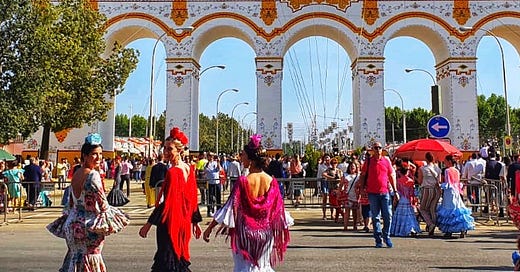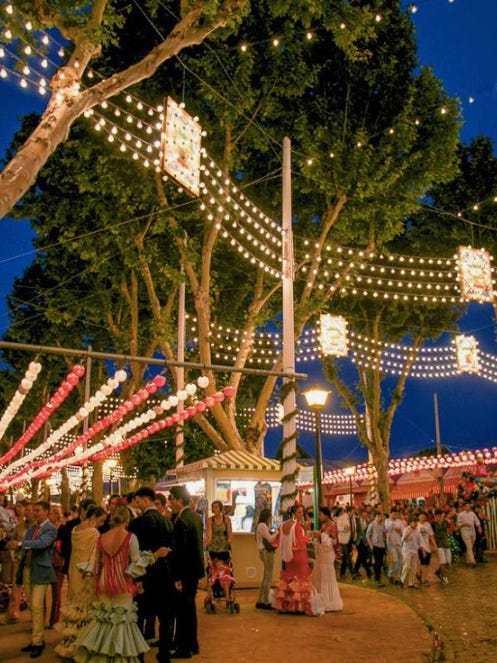Feria de Abril Part One: It Smells Like Feria // "Ya Huele a Feria"
The best week of the year, Feria de Abril, is almost upon us here in Sevilla.
Ya Huele a Feria. Literally translated, “it already smells like feria” but really it’s meant as “Feria is around the corner!”
This ubiquitous Sevillano phrase is said every year, a few months before feria and all the weeks and days leading up to it. It’s the feria mantra. This year I first heard it in January in my spinning class. Our instructor started the class excitedly with a typical Sevillanas song and yelled, “ya huele a feria!!” It was meant as a motivator to give the class our all, in the same way one might prep for “summer bod”. I wanted to write this article then, but here we are 2 weeks away from Feria and now it really smells like Feria.
Feria is an annual “spring fair” but similar how the word “float” falls short of capturing what pasos are, I feel obligated to refer to feria as feria in English. Feria means too much to be translated to in one or two English words. Feria deserves a full post, and feria deserves to be lived in person if you can swing it.
A Quick Lay of the Land
Feria is an annual week long celebration that originally was a livestock fair and has now evolved into a week that encapsulates everything that makes Andalucia special. It’s a week that captures years of tradition, joy, and you guessed it, socialization. All wrapped up in beautiful bow of men and women dressed to the nines.
In Sevilla, feria is always 2 weeks after Semana Santa/Easter. However there are ferias all throughout Andalucia and Spain and the dates vary based on each town or city.
Feria happens in a huge dirt lot close to the neighborhood of Los Remedios. It’s about 24 blocks long, with 15 actual streets named after famous Spanish toreros. The feria is split into two sections: the casetas section and the “attractions/roller coaster” section. The attractions section is for kids and adolescents, with lots of roller coasters that look like they’re about to fall apart any moment, and kiosks selling food, cotton candy, and the like. That section is more along the lines of what an America might envision as a typical fair. The casetas section, however, is unlike anything you’ve seen before. It’s basically a mini city of a bunch of casetas which are marquee tents. These tents are fully decked out with paintings, decorations, furniture, a bar, even a kitchen and bathrooms.
There’s an actual map with the names of the different streets, and each caseta has a number. The thing with Sevilla in comparison to other ferias is that the casetas are private. This is a good thing or bad thing depending on if you’re from Sevilla or not. Those who are not from Sevilla can have a hard time enjoying feria in the same way local Sevillanos do. However if you’re fortunate enough to know someone with a caseta, then the Sevilla feria is the crème de la crème of ferias.
How Feria (in Sevilla) Works
Admittedly there’s a bit of exclusivity to feria in Sevilla, and this is what makes it challenging to truly enjoy unless you live here. What I love about feria is that it’s like having all of your different friend groups within just a few blocks, for a week in a row. Different friend groups are at different casetas and you can essentially “caseta hop” to different casetas to see different friends. Naturally even within one friend group people will split up, maybe one person is at their aunt’s caseta while another friend is at their company’s caseta. There are even university faculty casetas, so if you studied engineering at the University of Sevilla, well you can reunite with all fellow alumni there each year.
Going to a caseta is similar to going to a bar except instead of a bunch of random strangers, everyone in the caseta knows everyone, or at least is connected by just a degree or two of separation. You’re at a place where most people know the people you care about, or even better it’s a caseta full of everyone that you care about. This creates a community feel unlike what you might get on just your average night out. Not to mention, the casetas are decked out in feria decor, adorned with traditional posters from previous ferias, typical feria lanterns, and more. There’s usually a stage in the caseta as well for the live bands that play at the casetas.
The reason the casetas are private is that each caseta has an annual fee in order to be a member. Don’t have a caseta? No worries, the wait list is just about 30+ years long to become a member. That being said, like many things in Spain, if you have an enchufe (a connection), you can get in sooner. I have two friends who became socios (members) just this year thanks to word of mouth as they replaced the previous socios, who they knew.
You might be thinking to yourself, so what if it’s private, it’s a marquee tent, can’t I just walk in? All casetas have at least one portero (doorman/security guy) and the bigger ones have several. Depending on the caseta these porteros are incredibly strict or a little more laid back. One of my friend’s casetas has a portero who won’t let you in unless she comes to the entrance and walks you in. Some casetas have a ticket system where the members can give you a ticket which you give at the entrance in order to get in.
The Attire
You may be familiar with the flamenco dresses worn at this festival, thanks to the popular 💃💃 emoji. This emoji is wearing a traje de flamenca, the most iconic outfit a woman can wear at feria.
The main theme at ferias is that you dress up. You can always spot the foreigners because they’re walking around in jeans or shorts, which is unacceptable according to the feria dress code.
Women typically wear flamenca dresses or simply dress to the nines. The full Feria outfit entails:
Traje de flamenca, these can vary in price from as cheap as 75 euros to thousands of euros. The average price for a nice traje is around 300-500 euros.
A mantoncillo, which is like a shawl, worn around your shoulders. There are several different styles to wear a mantoncillo and each year there tends to be 2-3 main styles that trend.
A fake flower, to be worn on top of your head for a classic look or off to the side if you don’t care so much about going with the traditional look.
Feria wedges.
Accessories: a brooch to hold the mantocillo together, oversize earrings, and hair pins.
Last note, your hair must be worn back! Unlike guiri me in 2013 who went to Feria and insisted on having my hair down. My friends tried to tell me but I didn’t understand until I got to feria.
Men at Feria wear suits or at the very least chinos, a collared button down and blazer.
Pescaito and the Alumbrao
The first night of feria is always a big one. In Sevilla feria kicks off on Saturday night, pescaito, and then lasts until the following Saturday at midnight. Traditionally feria in Sevilla used to start on Mondays and last until Sunday at midnight. This changed about 6 years ago so that feria would fall on 2 weekends (more money from tourism), much to the locals lament. I mention that because this year all Sevillano residents will be voting to decide if we’ll switch it back to the old way.
Pescaito is really meant for the caseta members. It’s when the final decorations have been put up in the caseta and it’s a way to inaugurate the beginning of feria. While in general you can enter casetas if you know someone who has a caseta, pescaito is typically meant for the actual members so it’s harder to get an invite. However, that doesn’t stop everyone from partaking, whether at restaurants close by or at a house party. We have dinner at a restaurant close by, we made reservations in December including paying a mandatory deposit. When we called in December we were told we were taking the last available table, just to give you an idea the anticipation that precedes feria.
After dinner, everyone heads to the portada, the giant “gate” at the feria entrance. Each year the design changes and it’s the spot to take photos. Right at midnight is the alumbrao, when the entire portada lights up to signal the official start of feria. Everyone cheers and claps and then heads off to the casetas for a night of dancing.
The Food & Drinks
As mentioned, in feria the casetas have full on bars and kitchens so you can eat and drink. Real feriantes will arrive at lunch and stay through dinner, much like the typical Friday lunches that last until dinner.
At most casetas the food isn’t anything too special. Typical feria food includes fried fish, tortilla de patatas, cured meats and cheeses, and lastly montaditos (little sandwiches). If you have a caseta with really good food it’s something you likely brag about. I know which friends’ casetas are the ones with good food and those are the ones we typically try to eat at.
You can’t talk about feria without mentioning rebujito. This is the most typical drink in feria. It’s a sherry wine, manzanilla, mixed with sprite or 7up, always served in a jarra (pitcher) so it can be shared with a group. The reason this drink is so popular in feria is that A. it’s easy to drink and B. it’s quite refreshing.
Temperatures in Sevilla during feria can get up into the 80s. Men wearing suits, women wearing heavy long-sleeved dresses…you can imagine the sweat! Rebujito is a great way to stay cool. The very taste is imbued with all that is feria. You won’t drink rebujito at any other time of the year. Spaniards love their traditions!
Dancing Sevillanas
One of the most important parts of feria is Sevillanas. I’ve been in Sevillanas classes since January preparing and the class has gotten fuller and fuller as we inch closer to feria. This week there are 4 extra classes at the local dance academy, just to make sure everyone is in top feria shape. I’ll share more about this dance and what makes it so special next week!











Ah this sounds amazing!! On the bucket list it goes..... 💃🏼
Wonderful first-hand account and great photos!! I have yet to be in Seville at the right time for the feria. One day! :)